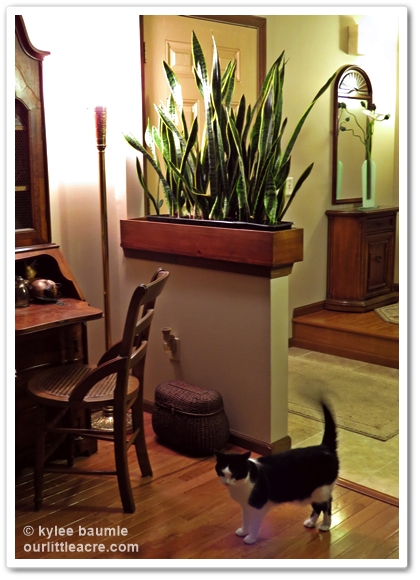When Jenny Peterson and I were writing our book, Indoor Plant Decor: The Design Stylebook for Houseplants, one of the ideas we shared for using houseplants as a design element was as a room divider.
 |
| From Indoor Plant Decor: The Design Stylebook for Houseplants |
The photo on page 83 of the Traditional Mix chapter shows how I used this concept in my own entry/living room. Our house was built in 1975 and when we bought it in 1977, we never gave the spindled half-wall a second thought. It's just how things were traditionally done back then.
Over the years, I came to hate those spindles. First of all, they have a colonial/Early American look to them and I'm just not a fan of that style. I knew that one day those spindles would be history, but I didn't know just what I'd do there, after their demise.
I don't remember now how the idea of putting a planter atop that half-wall came about, but my handy dandy dad constructed it and I planted it up.
That spot doesn't get the most light in the world - only indirect light from the windows in the living room - so I needed something that would do well under low light conditions.
ZZ plant (Zamioculcas zamiifolia) fit the bill. It's one of the easiest houseplants in the world, not being fussy about anything, including light and water. I planted it in 2011 and just recently decided it needed an overhaul. Most of the plants were fine, but I'd lost a few over the years, due to my truly neglecting them, as in I forgot to water them for a couple of months. (See? I'm not much different than you are!)
It was time for a change. And here's how it looks now:
Those sansevierias are stuffed in there. I wanted to put some ivy in at the base too, but there simply wasn't any room for it. There are a lot of new shoots coming up from the roots and I'll likely have to thin them at some point, but they're slow-growing so this should be good for quite a while.
Also called snake plant and mother-in-law's tongue, this succulent is known to be one that thrives on neglect, although you do need to remember to water it now and then. They prefer bright light, but will also grow in shade, making it highly adaptable as a houseplant.
Another benefit of Sansevieria trifasciata? It's one of the plants known for cleaning the air of toxins.
For more ideas on how to use plants to enhance your individual style inside your home, see our book, Indoor Plant Decor: The Design Stylebook for Houseplants. It's available at Amazon, Barnes & Noble and other booksellers, as well as directly from me as a signed copy.



2 comments:
What a great idea! Sanseverias are not my favorite houseplant but this is a dramatic idea and shows them at their best.
Kylee, what a great idea! I probably would have just knocked the whole wall down...yours is a much better idea! ~Julie
Post a Comment